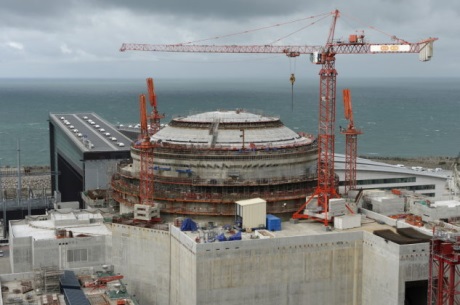The EPR under construction at Flamanville in northern France is now expected to begin operating in 2017, EDF has announced. The company attributed the further delay to the delivery of certain components and regulatory issues.
 |
| The scene of the Flamanville EPR construction site in September 2014 (Image: EDF) |
"Preparatory work in connection with the project review that will take place at end of November with all suppliers has shown a shift in the construction schedule," EDF said on 18 November. It said that the plant is now scheduled to start in 2017 instead of the earlier planned 2016.
EDF said the delayed completion of the Flamanville EPR results from "difficulties encountered" by supplier Areva in the delivery of certain pieces of equipment and the "implementation of the regulation on equipment under nuclear pressure (ESPN)."
According to EDF, Areva has had problems delivering the reactor vessel head and the internal structures of the vessel. It said that Areva has also provided an update on the ongoing analysis performed on the steam generators' welding defect, on qualification tests of the pressurizer valves, and on a detailed metallurgical analysis of the vessel head material.
Areva suspends outlook
The announcement of the further delay in construction of the Flamanville EPR came as Areva said it was suspending its financial outlook for 2015 and 2016.
Areva said the suspension was the result of several factors. These include the rescheduling of the completion of the Olkiluoto EPR and uncertainty about when it would receive payments from its customer, TVO. The rescheduling of other new nuclear start-ups was also a factor, as was the continued shut down of Japan's reactors.
The company said, "In the framework of the ongoing budget process, Areva is currently working on an enhancement of its performance plan to adapt to market conditions which remain unfavourable."
With regards to problems in implementing ESPN standards, EDF said that this particularly applies to "a set of assembly [sic] carried out by Areva and its subcontractors."
"This new information will be shared with all suppliers and will be integrated in the construction schedule, with a view to adapt and coordinate the work on site," EDF said. The forthcoming project review, it added, "will allow, with the group of subcontractors, to define accurately the consequences of the information now available to the group in order to take all the necessary decisions for the completion of construction."
Construction work began on the 1650 MWe unit at the Normandy site in December 2007. EDF is architect engineer of the project, while Areva is contributing the nuclear steam supply system and Bouygues Construction is leading the civil engineering consortium. The dome of the reactor building was put in place in mid-July 2013, while the reactor vessel was installed in January. The reactor was originally expected to start commercial operation in 2013, but its expected start-up was later pushed back to 2016.
EPRs are also under construction at Olkiluoto 3 in Finland and Taishan 1 and 2 in China. Olkiluoto 3 has been under construction since 2005 and has seen several revisions to its start-up date, which is now expected by 2018. Taishan 1, which has been under construction since 2009, is expected to start up in 2016, while Taishan 2 is scheduled to begin operating a year later.
EDF said, "In spite of these construction contingencies, EDF reaffirms its commitment to new nuclear in France, China and the United Kingdom."
Researched and written
by World Nuclear News





_18570.jpg)
_16159.jpg)
_18938.jpg)
_33584.jpg)





